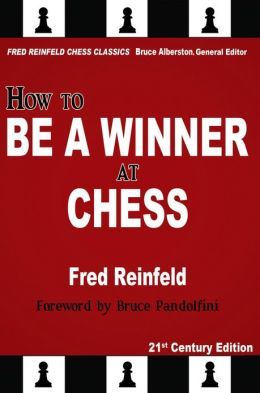How to Be a Winner at Chess
Fred Reinfeld

The United States may never switch to the metric system but the debate over whether to use English Descriptive or Algebraic notation has long been decided. Back when I started playing in the fall of 1972 English Descriptive held sway, but by 1980 the number of players who wrote down 1.P-K4 on their scoresheets was rapidly declining. Almost all magazines and publishers had made the switch by then, Andy Soltis Chess to Enjoy column in Chess Life the last notable exception, holding out until about 2001.
While the transition to the more space efficient and logical Algebraic was a positive step, it had a negative side albeit one that did not immediately surface. When the switch was made in the 1980s almost all the players were “bilingual, able to play over games in either notation. That is no longer the case today when many if not most players under 40 are unfamiliar with English Descriptive.
Thats a shame as some of the greatest literature in the history of the game is only available in English in the “old notation. Recently publishers have started to correct this state of affairs with Russell Enterprises, Inc. among the leaders. The past few years it has produced “21st Century Editions of classic tournament books like New York 1924 and Nottingham 1936. Now it has switched its attention to game collections and instructional works.
You cant find a more classic game collection than Alexander Alekhines work on his games covering the period 1908-1937. Originally published in two volumes, this work has stood the test of time not only because of the quality of the games (current world number two Levon Aronian rates Alekhine the greatest player of all time) but because of the quality of the notes which stand out for their instructional value.
Alekhine has been accused, and not without some justification, of embellishing just how much he saw over the board. Reading his notes one wonders if any human would ever be able to conceive and implement a five stage plan seemingly without any resistance from his opponent as he claims to have done, but that in no way detracts from the games pedagogical value. Today the top players efforts are complex and messy often extremely difficult for the non-professionals to follow. Such was not the case in Alekhines time. His dynamic style of play would fit in very well today but few of his opponents in the 1920s and 1930s were equipped with the skills to resist this giant. The result is a series of games in which Alekhine imposes his will on his opponents. These “crime and punishment lessons are extremely instructive for the student who wishes to improve their understanding of chess.
Russell Enterprises has combined the two books into one 456 page softcover volume that sells for $34.95. As a bonus a comprehensive computer-assisted analytical supplement has also been prepared and is available for download at no extra charge, so that, if you wish, you may compare Alekhines impressive notes with the preferences of the silicon monster. In this reviewers opinion it is the instructive prose that makes this book especially valuable not the concrete variations that are offered.
Highly Recommended.
Two other Russell Enterprise 21st Century Editions conversions from Descriptive to Algebraic notation are How to Play Chess Like a Champion and How to Be a Winner at Chess, both by Fred Reinfeld. One of the most prolific authors in the history of the game, Reinfeld is sometimes dismissed as a weak player who was an endless recycler of his own material aimed at the beginner market. This is not accurate.
The fact is that Fred Reinfeld (b. 1910) was a very promising player in his late teens and early twenties, one of a group of young American talents that included Arthur Dake (b. 1910), Sammy Reshevsky (b. 1911) and Reuben Fine (b. 1914). All made their debuts on the big stage at Pasadena 1932 where Reinfeld scored 5 from 11 including a draw with Alekhine. He never matched this success but did have some solid performances including finishing second at Ventnor City 1939 and 1941 and scoring 7.5 from 16 in the 1940 U.S. Championship.
During the 1930s Reinfeld not only wrote but produced (on a mimeograph machine) a series of tournament books and game collections that were critical if not commercial successes. It was only after World War 2 that he emerged as a chess popularizer. While he might have aimed at a wider audience, Reinfeld still offered plenty of practical advice that is as true today as when he wrote it. A case in point can be found on page 74 of How to Be a Winner at Chess where under the heading of Simplify When You Have a Material Advantage he writes:
“Frank Marshall, the leading American Master for many years, once gave this sage advice: When you have the better of it, play simply. When the game is going against you, look for complications. This sounds pretty obvious but how many players below 2000 follow this sound counsel? Reinfeld knew the audience he was writing for.
All three of these offerings from Russell Enterprises, Inc. are neatly laid out with sturdy binding for long use.
